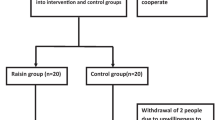Abstract
Onion (Allium cepa L.) is widely employed as a food ingredient as well as traditional remedy to treat fever, burns, and scurvy. The present study focused on the modulator efficacy of the quercetin rich onion juice on lipid profile and antioxidant status in mildly hypercholesterolemic subjects. Twenty-four healthy subjects with mild hypercholesterolemia (≧200 mg/dL) were recruited and divided into two groups, and they consumed 100 mL of onion juice or placebo every day for 8 weeks. Fasting blood samples were collected at initial, 2nd, 6th, 8th, 10th week for estimating various biochemical assays, as well as anthropometric indices. After 8 weeks of intervention, onion juice greatly decreased (p < 0.05) waist circumference, total cholesterol and LDL-c. In addition, it elevates (p < 0.05) total antioxidation capacity and prolong lag-time of LDL oxidation were also noted. To conclude, drinking onion juice could markedly suppress cholesterol level and elevate total antioxidation capacity. Hence, onion juice was probably recommended for combating various cardiovascular diseases.


Similar content being viewed by others
Abbreviations
- TC:
-
Total cholesterol
- TG:
-
Triglyceride
- HDL-c:
-
High Density Lipoprotein Cholesterol
- LDL-c:
-
Low Density Lipoprotein Cholesterol
- EXP:
-
Experimental group
- TEAC:
-
Trolox Equivalent Antioxidant Capacity
- TBARS:
-
Thiobarbituric Acid Reactive Substances
References
Stapleton PA, Goodwill AG, James ME, Brock RW, Frisbee JC (2010) Hypercholesterolemia and microvascular dysfunction, interventional strategies. J Inflam 7:54–64
Hein TW, Kuo L (1998) LDLs impair vasomotor function of the coronary microcirculation role of superoxide anions. Circulation Res 83:404–14
Arts ICW, Hollman PCH (2005) Polyphenols and disease risk in epidemiologic studies. Am J Clin Nutr 81(1):317S–325S
Griffiths G, Trueman L, Crowther T, Thomas B, Smith B (2002) Onions - a global benefit to health. Phytother Res 16:603–615
Joshi SC, Jain PK (2014) A review on hypolipidaemic and antioxidant potential of some medicinal plants. World J Pharm Sci 3(11):357–380
Srinivasan K (2013) Dietary spices as beneficial modulators of lipid profile in conditions of metabolic disorders and diseases. Food Funct 4:503–21
Julkunen-Titto R (1985) Phenolic constituents in the leaves of northern willows: methods for the analysis of certain phenolics. J Agric Food Chem 33:213–217
Hertog MGL, Hollman PCH, Venema DP (1992) Optimization of a quantitative HPLC determination of potentially anticarcinogenic flavonoids in vegetables and fruits. J Agric Food Chem 40:1591–1598
Crozier A, Michael E, McDonald MS, Black C (1997) Quantitative analysis of the flavonoid content of commercial tomatoes, onions, lettuce, and celery. J Agri Food Chem 45:590–595
Bordia A, Bansal H, Arora S, Singh S (1975) Effect of the essential oils of garlic and onion on alimentary hyperlipemia. Atherosclerosis 21:15–19
Serafini M, Maiani G, Ferro-Luzzi A (1998) Alcohol-free red wine enhances plasma antioxidant capacity in humans. J Nutr 128:1003–1007
Arnao MB, Casas JL, Del Rio JA, Acosta M, Garcia-Canovas F (1990) An enzymatic colorimetric method for measuring naringin using 2,20-azino-bis-(3- ethylbenzthiazoline-6-sulfonic acid) (ABTS) in the presence of peroxidase. Anal Biochem 185:335–338
Miller NJ, Rice-Evans C, Davies MJ, Gopinathan V, Milner A (1993) A novel method for measuring antioxidant capacity and its application to monitoring the antioxidant status in premature neonates. Clin Sci (Lond) 84:407–412
Draper HH, Hadley M (1990) Malondialdehyde determination as index of lipid peroxidation. Methods Enzymol 186:421–431
Halliwell B, Gutteridge JM (1990) The antioxidants of human extracellular fluids. Arch Biochem Biophys 280:1–8
Esterbauer H, Striegl G, Puhl H, Rotheneder M (1989) Continuous monitoring of in vitro oxidation of low density lipoprotein. Free Radic Res Commun 6:67–75
Kaneko T, Baba N (1999) Protective effect of flavonoids on endothelial cells against linoleic acid hydroperoxide-induced toxicity. Biosci Biotechnol Biochem 63:323–328
Benítez V, Mollá E, Martín-Cabrejas MA, Aguilera Y, López-Andréu FJ, Cools K, Esteban RM (2011) Characterization of industrial onion wastes (Allium cepa L.): dietary fibre and bioactive compounds. Plant Foods Hum Nutr 66(1):48–57
Rohn S, Buchner N, Driemel G, Rauser M, Kroh LW (2007) Thermal degradation of onion quercetin glucosides under roasting conditions. J Agric Food Chem 55:1568–1573
Hollman PC, Katan MB (1999) Health effects and bioavailability of dietary flavonols. Free Radic Res 31(1):S75–S80
Febrianti EZ, Asviandri FL, Lestari R, Cahyohadi S, Rini EA (2013) Correlation between lipid profiles and body mass index of adolescents obesity in Padang. Int J Ped Endocrinol 1:P87
Glasser G, Graefe EU, Struck F, Veit M, Gebhardt R (2002) Comparison of antioxidative capacities and inhibitory effects on cholesterol biosynthesis of quercetin and potential metabolites. Phytomed 9:33–40
Chávez-Santoscoy RA, Gutiérrez-Uribe JA, Serna-Saldívar SO (2013) Effect of flavonoids and saponins extracted from black bean (Phaseolus vulgaris L.) seed coats as cholesterol micelle disruptors. Plant Foods Hum Nutr 68(4):416–423
Arai Y, Watanabe S, Kimira M, Shimoi K, Mochizuki R, Kinae N (2000) Dietary intakes of flavonols, flavones and isoflavones by Japanese women and the inverse correlation between quercetin intake and plasma LDL cholesterol concentration. J Nutr 130:2243–2250
Lee KH, Park E, Lee HJ, Kim MO, Cha YJ, Kim JM, Lee H, Shi MJ (2011) Effects of daily quercetin-rich supplementation on cardiometabolic risks in male smokers. Nutr Res Pract 5(1):28–33
Rice-Evans CA, Miller NJ, Paganga G (1996) Structure-antioxidant activity relationships of flavonoids and phenolic acids. Free Rad Biol Med 20:933–956
Shon MY, Choi SD, Kahng GG, Nam SH, Sung NJ (2004) Antimutagenic, antioxidant and free radical scavenging activity of ethyl acetate extracts from white, yellow and red onions. Food Chem Toxicol 42:659–666
Hausenloy D, Yellon D (2008) Targeting residual cardiovascular risk: raising high-density lipoprotein cholesterol levels. Postgrad Med J 84:590–598
Osorio-Esquivel O, Ortiz-Moreno A, Garduño-Siciliano L, Álvarez VB, Hernández-Navarro MD (2012) Antihyperlipidemic effect of methanolic extract from Opuntia joconostle seeds in mice fed a hypercholesterolemic diet. Plant Plant Foods Hum Nutr 67(4):365–370
Conflicts of interest
None
Author information
Authors and Affiliations
Corresponding author
Rights and permissions
About this article
Cite this article
Lu, TM., Chiu, HF., Shen, YC. et al. Hypocholesterolemic Efficacy of Quercetin Rich Onion Juice in Healthy Mild Hypercholesterolemic Adults: A Pilot Study. Plant Foods Hum Nutr 70, 395–400 (2015). https://doi.org/10.1007/s11130-015-0507-4
Published:
Issue Date:
DOI: https://doi.org/10.1007/s11130-015-0507-4




